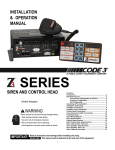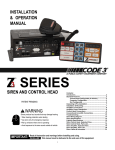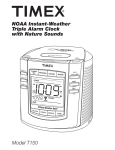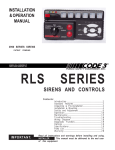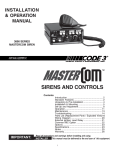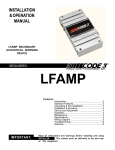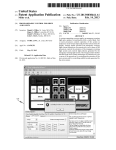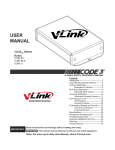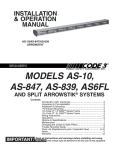Download Z3 Siren Installation Manual
Transcript
INSTALLATION
& OPERATION
MANUAL
$
*
8
9
:
8
9
;
<
=
>
>
?
@
@
A
B
C
D
D
B
>
E
F
G
>
<
E
H
I
>
J
A
B
>
<
E
H
K
D
A
L
@
>
M
@
B
0
%
'
!
#
(
(
+
-
,
)
&
'
&
.
.
/
,
%
2
-
.
/
.
.
.
1
.
.
!
.
!
.
#
.
(
3
Sirens produce loud sounds that may damage hearing
• Wear hearing protection when testing
• Use siren only for emergency response
• Roll up windows when siren is operating
• Avoid exposure to the siren sound outside of vehicle
IMPORTANT:
"
D
*
WARNING
7
*
6
4
5
'
,
3
2
4
5
'
,
"
&
Read all instruction and warnings before installing and using.
INSTALLER: This manual must be delivered to the end user of this equipment.
1
.
+
/
/
3
*
*
.
1
The Z3 Siren is a remote control electronic siren that has been designed to meet the needs of all emergency vehicles. The Z3 Siren incorporates
many of the popular features of the past and uses microprocessor based circuitry and MOSFET technology. All standard features are available along
with many new features that are not available on any other Code 3 siren: Fully Configurable 3-Level Switch, Selectable Tones, Adjustable
Backlighting and much more. The Z3 Siren can be controlled by the Steering Wheel Interface Ford P.I. Sedan and Utility (The Z3-SWIF).
!
WARNING
Sirens are an integral part of an effective audio/visual emergency warning system. However, sirens are only short range
secondary warning devices. The use of a siren does not insure that all drivers can or will observe or react to an emergency
warning signal, particularly at long distances or when either vehicle is traveling at a high rate of speed. Sirens should only be
used in a combination with effective warning lights and never relied upon as a sole warning signal. Never take the right of way
for granted. It is your responsibility to be sure you can proceed safely before entering an intersection driving against traffic, or
responding at a high rate of speed.
The effectiveness of this warning device is highly dependent upon correct mounting and wiring. Read and follow the
manufacturer’s instructions before installing this device. The vehicle operator should check the equipment daily to insure that
all features of the device operate correctly.
To be effective, sirens must produce high sound levels that potentially can inflict hearing damage. Installers should be warned
to wear hearing protection, clear bystanders from the area and not to operate the siren indoors during testing. Vehicle operators
and occupants should assess their exposure to siren noise and determine what steps, such as consultation with professionals
or use of hearing protection should be implemented to protect their hearing.
This equipment is intended for use by authorized personnel only. It is the user’s responsibility to understand and obey all laws
regarding emergency warning devices. The user should check all applicable city, state and federal laws and regulations. Code
3, Inc., assumes no liability for any loss resulting from the use of this warning device.
Proper installation is vital to the performance of the siren and the safe operation of the emergency vehicle. It is important to
recognize that the operator of the emergency vehicle is under psychological and physiological stress caused by the emergency
situation. The siren system should be installed in such a manner as to: A) Not reduce the acoustical performance of the system,
B) Limit as much as practical the noise level in the passenger compartment of the vehicle, C) Place the controls within convenient
reach of the operator so that he can operate the system without losing eye contact with the roadway.
Emergency warning devices often require high electrical voltages and/or currents. Properly protect and use caution around live
electrical connections. Grounding or shorting of electrical connections can cause high current arcing, which can cause personal
injury and/or severe vehicle damage, including fire.
PROPER INSTALLATION COMBINED WITH OPERATOR TRAINING IN THE PROPER USE OF EMERGENCY WARNING
DEVICES IS ESSENTIAL TO INSURE THE SAFETY OF EMERGENCY PERSONNEL AND THE PUBLIC.
The Z3 Siren consists of a remotely mounted siren amplifier with integral lighting control. This is operated by a compact control panel designed to be
conveniently mounted near the operator. This model includes the following standard features:
- Primary Push-Buttons: WAIL, YELP, ALT TONE (Default Tone for ALT TONE is Hi-Lo 1 but can be configured to use other tones).
- Secondary Tones: Multiple User Configurable Tones.
- MANUAL Push-Button: Default tone is the Manual Wail.
- AIR HORN Push-Button: Default tone is Air Horn 1.
- 8 Auxiliary Controls: Default to control Auxiliary A through Auxiliary H outputs. Can be configured to control multiple Auxiliary outputs from one
Auxiliary push-button.
- ArrowStik Control: Multiple User Configurable Flash Patterns (For use with conventional ArrowStik).
- Integrated Centrally Controlled ArrowStik.
- Integrated Code 3 Serial Lightbar Control.
!
WARNING
IMPORTANT WARNINGS TO USERS OF SIRENS: “Wail” and “Yelp” tones are in some cases (such as the state of California)
the only recognized siren tones for calling for the right of way. Ancillary tones such as “Air Horn”, “Hi-Lo”, “Hyper-Yelp”, and
“Hyper-Lo” in some cases do not provide as high a sound pressure level. It is recommended that these tones be used in a
secondary mode to alert motorists to the presence of multiple emergency vehicles or to the momentary shift from the primary
tone as an indication of the imminent presence of any emergency vehicle.
2
Control Head Configurable (In Vehicle)
Adjustable Backlighting - The Backlighting can be
adjusted as desired. Press and hold either the LEFT or
RIGHT push-buttons for one second. This puts the Control
Head into an adjustment mode for the backlighting.
Repeatedly press or hold the RIGHT push-button to
increase the brightness or the LEFT push-button to
decrease the brightness. The brightness can be decreased
down to include an off condition. Press the DIM push-button
to exit from this adjustment mode. There is also a time-out
that will save the settings before exiting as well.
Microphone Volume Adjustment - Press and hold the
PTT push-button on the microphone. Then press and hold
the Left or Right push-button for one second to enter the
volume adjustment mode. Press the Left or Right arrow
push-buttons to decrease or increase the volume, respectively. Once it’s adjusted to the desired volume, press the
DIM push-button or release the PTT push-button to save
the setting. There is also a time-out that will save the settings before exiting as well.
Radio Rebroadcast (RRB) - Radio ReBroadcast over siren
speakers. These inputs are transformer coupled to prevent
Figure 1
loading of the radio. The audio from the radio is rebroadcast
over the siren speakers. The siren tones do not operate when this is activated. All other control functions operate normally. To connect in the signal
to be broadcast, simply connect the two signal lines to the RRB1 and RRB2 inputs of the Amplifier (polarity is not an issue). The default setting of
the Z3 Siren has this option turned off. See the Z3 Software User Manual for configuring one of the Auxiliary push-buttons for activating this feature.
Once configured to an Auxiliary push-button and that push button is activated, only then can the volume be adjusted by holding down the RIGHT or
LEFT push-button for one second. Pressing the RIGHT or LEFT push-button increases or decreases the volume. Pressing the DIM push-button will
save the settings. There is also a time-out that will save the settings before exiting as well. The RRB feature will automatically shutoff to protect from
overheating of the Z3 Siren.
Computer Configurable
WAIL Push-Button - This push-button produces the Wail tone when pressed. By default, it also turns on the Level 3 lights but this is configurable
to Level 2, Level 1 or no lights. The override tone is also configurable for this feature. Pressing the push-button a second time turns this feature off.
Operation of this feature is affected by SirenLock, 3-Level Switch and Park Kill features. See these sections for details.
YELP Push-Button - This push-button produces the Yelp tone when pressed. By default, it also turns on the Level 3 lights but this is configurable
to Level 2, Level 1 or no lights. The override tone is also configurable for this feature. Pressing the push-button a second time turns this feature off.
Operation of this feature is affected by SirenLock, 3-Level Switch and Park Kill features. See these sections for details.
ALT TONE Push-Button - Both the primary and override tones are configurable for this push-button. This push-button produces the Hi-Lo 1 tone
when pressed. It also turns on the Level 3 lights but this is configurable to Level 2, Level 1 or no lights. The override tone is the Hyper-Lo 1 tone.
Pressing the push-button a second time turns this feature off. This push-button can be disabled in the configuration software. Operation of this
feature is affected by SirenLock, 3-Level Switch and Park Kill features. See these sections for details.
MANUAL Push-Button - In its default configuration, this push-button generates the Manual Wail tone. When pressed, the Manual Wail tone will
ramp up to the maximum tone and hold. It will hold as long as the MANUAL push-button is held. When the MANUAL push-button is released, the
tone will ramp down and return to the previous function. The configuration software can change this to be in Hit-N-Go mode, Scroll mode, or Wail
Stop mode. This can also be configured to react differently based on Siren status or Disabled. Operation of this feature is affected by SirenLock,
3-Level Switch and Park Kill features. See these sections for details.
AIR HORN Push-Button - In its default configuration, the AIR HORN push-button produces the Air Horn 1 tone as long as it is pressed. It will
override all other siren tones. The configuration software can set this tone to Air Horn 1 or Air Horn 2 or to disable the AIR HORN push-button.
The AIR HORN push-button will work with Park Kill and SirenLock. See the Z3 Siren Configuration Software User Manual for configuration details.
3
Computer Configurable-Cont:
Auxiliary A-H Push-Buttons -As configured by the Z3 Siren Configuration Software, eight on/off Auxiliary push-buttons are readily accessible for
controlling the Auxiliary outputs of the Amplifier. Each Auxiliary push-button can be custom labeled with the supplied label kit. Each push-button is
backlighted when activated to alert the operator. The default setting is for each Auxiliary push-button to control the corresponding Auxiliary output of
the Amplifier. Auxiliary A through F supplies power to the load through the connector pins labeled A thru F. Auxiliary G and H supplies power with a
positive or ground voltage to the load through the connector pins labeled G and H. All eight Auxiliary push buttons can be configured to be disabled
with the vehicle ignition. Please see the Z3 Siren Configuration Software User’s Manual for details.
3-Level Switch - The Control Head provides a 3-Level Switch for changing the emergency warning mode. The 3-Level Switch is located in the
top left corner of the control head. When the 3-Level Switch is switched to the far left position, the unit is off. When the 3-Level Switch is in the first
position from the left, the level 1 configuration of the lights is turned on. When the 3-Level Switch is in the second position from the left, the level 1
& 2 configuration of lights are turned on. When the 3-Level Switch is in the third position from the left, the level 1, 2, & 3 configuration of the lights
are turned on. Level 1, 2, & 3 activate the LightAlert. These default settings can be altered using the Z3 Siren Configuration Software. The 3-Level
Switch may be overridden by other push-buttons. If the push-buttons are programmed to a higher level than the position of the 3-Level Switch, the
push-buttons will take precedence. If the push-buttons are programmed to a lower level than the position of the 3-Level Switch, the 3-Level Switch
will take precedence. The lighting can be set to various levels for the WAIL, YELP, ALT TONE, MANUAL, and AUX push-buttons. Visit these sections
in the configuration software to set these preferences.
3-Color Status LED - Three LEDs are visible on the Z3 Control Head. When the 3-Level Switch is set to Level 1 the green LED lights. When the
3-Level Switch is set to Level 2 both the green and yellow LEDs light. When the 3-Level Switch is set to Level 3 the green, yellow, and red LEDs
light. These LEDs indicate the level of the siren and controls. These levels are configurable in the Z3 Siren Configuration Software User Manual.
Hands-Free - The Hands-Free mode is directly linked to the Auxiliary push-buttons. By default, the Hands-Free mode is disabled. When an Auxiliary
push-button is configured for Hands-Free and that Auxiliary push-button has been turned on, the Hands-Free mode is active, but waiting for an initial
press of the horn ring to activate the WAIL push-button. A second press of the horn ring will activate the YELP push-button. Pressing the horn ring a
third time will activate the ALT TONE push-button. A fourth press of the horn ring will return to the WAIL push-button. This type of scrolling will
continue until the user deactivates the Hands-Free Scroll. Pressing the Auxiliary push-button turns off the tone and deactivates the Hands-Free
Scroll. Pressing and holding the horn ring will turn off the tone, but leave Hands-Free in the active mode. The Remote input and Manual push-button
can also be configured for multiple functions during Hands-Free mode. Please refer to Z3 Siren Configuration Manual for details.
Horn Ring - The Z3 Siren accepts either a positive or a ground signal into the Horn Ring input. The Horn Ring signal is disconnected from the
vehicle and connected to the Horn Ring input. The Horn Relay wire is then run from the Amplifier to the horn of the vehicle. This allows the Horn Ring
to execute some of the user selectable functions of the Z3 Siren. The Horn Ring can be configured to multiple functions in the Siren Active and Siren
Inactive modes of operation. The Horn Ring is set to Scroll in the Hands-Free mode and cannot be changed. Please see the Z3 Siren Configuration
Software User’s Manual for details.
Horn Ring Transfer - The Horn Ring Transfer allows the Horn Ring to be disabled from the vehicle horn and the controls transferred to control other
siren tones. The Horn Ring Transfer can be set to occur at Level 1, Level 2 or Level 3.
Remote - The Z3 Siren accepts either a positive or a ground signal into the Remote Input. The Remote Input is designed to be connected to a user
supplied switch. The Z3 Siren is factory set for a ground signal. The Remote input can be configured to multiple functions in the Siren Active, Siren
Inactive and Hands-Free modes of operation. Please refer to the Z3 Siren Configuration Software User’s Manual for details.
Hit-N-Go - Hit-N-Go only works when a siren tone is active. Once a siren tone is active, Hit-N-Go is activated simply by pressing the vehicle horn
ring or activating the Remote input. It will go to the Override tone for 8 seconds and then return to the primary tone. The actual tone for the Hit-N-Go
depends on which push-button is active. If the WAIL push-button is active then the Hit-N-Go (Override) tone is the Yelp tone. If the YELP push-button
is active then the Hit-N-Go tone is the Hyper-Yelp 1 tone and if the ALT TONE push-button is active then the Hit-N-Go tone is the Hyper-Lo 1 tone.
These Override tones are user configurable in the Configuration Software. The Z3 Siren can also be configured so the MANUAL push-button is
Hit-N-Go activator.
The InterClear output will turn on for 8 seconds anytime the Z3 Siren operates the Hit-N-Go mode. The InterClear output provides a +12V
signal to control an external device for additional warning.
N
O
P
Q
R
Scroll - Scroll only works when a siren tone is active. Once a siren tone is active, Scroll is activated simply by pressing the vehicle horn ring or
activating the Remote input. The Z3 Siren will Scroll from Wail to Yelp to Alt and then back to Wail. Holding the vehicle horn ring for greater than a
half second will cause the Z3 Siren to generate the Air Horn. The siren can also be configured so the MANUAL push-button activates Scroll.
The InterClear output will turn on for 8 seconds anytime the Z3 Siren operates the Scroll mode. The InterClear output provides a +12V
signal to control an external device for additional warning.
N
O
P
Q
R
4
Computer Configurable-Cont:
Scroll On/Off - The Scroll On/Off mode works like the Scroll mode except the Z3 Siren will scroll the primary tones through an off state. The Z3 Siren
will scroll from Off to Wail to Yelp to Alt Tone and then back to Off. The Remote input can be configured to activate Scroll On/Off. Holding the vehicle
horn ring for greater than a half second will cause the Z3 Siren to generate the Air Horn.
The InterClear output will turn on for 8 seconds anytime the Z3 Siren operates the Scroll On/Off mode. The InterClear output provides a
+12V signal to control an external device for additional warning.
S
T
U
V
W
Load Management - The Load Manager allows setup of three Dropout Voltage Groups by selecting which output to drop out when the vehicle power
levels fall below the specified voltage for that group. The default is for no groups to drop out. See the Z3 Siren Configuration Software User Manual
for configuration details.
LoadMGRTM - This output can control the power supplied to other loads in the vehicle. The power to these loads can be turned off when the driver
turns off the vehicle or the voltage of the battery for the vehicle has dropped below a predetermined voltage level. If the Sleep Mode timer is set to a
value other than instant, the LoadMGR will turn off after the Sleep Mode timer has expired (see the definition of Sleep Mode). This output is current
limited to 1 amp continuous. Connecting the LoadMGR output to an external relay will allow larger external loads to be controlled. The InterClear®
wire is used for the LoadMGR function. InterClear and LoadMGR cannot be configured simultaneously.
Overvoltage Protection - The Z3 Siren is designed with an enhanced Overvoltage Protection circuit. This circuit will monitor the input voltage to the
Z3 Siren and will shut off the siren tones if an overvoltage condition is detected. This protects the speaker driver from damage. This feature has been
enhanced to operate with today’s vehicle charging systems. The Z3 Siren will generate siren tones for 15 minutes even in an overvoltage condition.
After 15 minutes the siren tones will be turned off. If the siren tones are still required, the tone can be turned off and on again by pressing the siren
tone push-button. This will provide an additional 15 minutes of operation. This feature can be disabled.
Please see the Z3 Siren Configuration Software User’s Manual for details.
Park Kill - By default, the Park Kill puts the siren tones in standby and drops out the Level 3A output. Park Kill occurs when the vehicle is shifted into
park. The default for the polarity of the Park Kill input is ground (configurable to a +12V). Once Park Kill is activated, the siren tones are in standby.
The siren tones will remain in standby until the vehicle is shifted into drive and an action occurs such as pressing one of the Control Head
push-buttons, changing the position of the 3-Level Switch, or keying the microphone. The Level 3A and siren tones are in standby during Park Kill
and the Auxiliary push-buttons are not affected by the Park Kill function by default. See the Z3 Siren Configuration Software manual for details.
InterClear® - The InterClear output will turn on for 8 seconds anytime the Z3 Siren operates the Hit-N-Go, Scroll, Scroll On/Off or Hands-Free Scroll.
The InterClear output provides a +12V signal to control an external device for additional warning. It is internally current limited at 1 Amp. The
InterClear feature is disabled if the LoadMGR is configured. See the Z3 Siren Configuration Software manual for details.
EU Lock - This function is to meet the requirements of some European Union countries to verify that the Warning Lights for the emergency vehicle
are operational before allowing the siren to generate tones. This is normally disabled. When configured as the EU Lock input all other configurations
of the Remote are disabled. In this mode, the Remote is connected to a user supplied light sense module that provides a signal that indicates if the
emergency lights are operational or not. When there is no signal to the Remote input all siren tones will be disabled.
SirenLock - SirenLock is used to set which 3-Level Switch position (Level 1, 2 or 3) will allow the Z3 Siren to generate the Primary tones. When
SirenLock is enabled, the Z3 Siren is ‘Locked’ from generating Primary tones until the configured 3-Level Switch position is activated. SirenLock
does not affect the MANUAL and AIR HORN push-buttons. The default for SirenLock is disabled and the Z3 Siren will generate Primary tones when
the push-button (Wail, Yelp or Alt) is activated regardless of the position of the 3-Level Switch.
LightAlert - By default, the LightAlert feature will produce an audible “beep” on a periodic basis if any lighting is activated including Auxiliary and
ArrowStik push-buttons. This is intended to alert the operator that lights are on. The Z3 Siren Configuration Software allows this feature to be
disabled for individual functions.
Sleep Mode - This is by default set to instantly turn off the Z3 Siren when the vehicle ignition is turned off. This can also be set in the configuration
software to turn off after 10, 20, or 30 minutes or 1, 2, or 4 hours. The Z3 Siren can be forced to exit Sleep Mode and turn off instantly by pressing
and holding the FLASH push-button for 1 second.
5
Not Configurable
Alarm - Connect the wire labeled ALARM to a circuit that can supply a +12VDC signal when activated. When a +12VDC signal is seen on this input,
a repetitive alarm will sound on the output speakers until the +12VDC signal is removed. For example, this can be used to alarm the police officer
when a temperature sensor on a K-9 unit has reached dangerous levels. The ALARM input will operate with the IGNITION input on or off.
Automatic Short Circuit Protection - The Z3 Siren will sense a short circuit on the speaker outputs and automatically go into standby until the fault
is removed. Once the fault is removed, the Z3 Siren will return to normal operation.
Power Up Self Test - When the Z3 Siren system is powered up with the vehicle ignition, it will test the communication between the Amplifier and the
Control Head. If this test fails, the Control Head will blink all LEDs and beep until communication is established.
Instant On - There is no “ON/OFF” switch. If the Z3 Siren is properly installed and the vehicle’s ignition is switched on, selecting any siren function or
keying the microphone will activate the selected siren function.
Microphone - Push-To-Talk (PTT) is highest priority and overrides all other siren tones. Pressing the push-button on the microphone will
automatically override all siren tones and switch to the public address mode. The microphone is easily plugged into the Control Head with a modular
phone plug. This allows the microphone to be unplugged for easy service or replacement.
Stuck Mic - If the PTT is pressed for 30 seconds , the Z3 Siren will disable the PTT and return to the previous operation. This will avoid the situation
where the PTT is “stuck” in the one position for extended periods. To continue using the PTT, release the PTT and press it again.
Blown Fuse Indicator - The Z3 Siren will give a visual warning if there is no power being supplied to any 3-Level output or to the Auxiliary A through
F outputs. This can be caused by a loss of power to the Z3 Siren power harness or by a blown fuse in the Z3 Siren. If any 3-Level output has no
power, the 3-Level Switch LEDs will blink to indicate that there is a fault. If any of the Auxiliary A through F outputs has no power, all activated
Auxiliary A through F LEDs will blink to indicate that there is a fault. The fuses can be easily accessed through the top of the Z3 Siren.
6
7
LEFT
CENTER
RIGHT
FLASH
DIM
Level 1
Level 2
Level 3
Group 1
Group 2
Group 3
Overvoltage Protection
SirenLock
Other Push-Button Settings
WAIL
YELP
ALT TONE
MANUAL
AIR HORN
AUX A
AUX B
AUX C
AUX D
AUX E
AUX F
AUX G
AUX H
Horn Ring
Park Kill
LightAlert
Sleep Mode
CA T13
Remote
Load Management
ArrowStik
3-Level Switch
Primary Tone = Wail
Primary Tone = Yelp
Primary Tone = Hi-Lo 1
Siren Active = Manual Wail
Enable = Always Enabled
Function Enabled
Function Enabled
Function Enabled
Function Enabled
Function Enabled
Function Enabled
Function Enabled
Function Enabled
Voltage Fault Threshold = 11.50 Volts
Voltage Fault Threshold = 11.00 Volts
Voltage Fault Threshold = 10.50 Volts
Enabled
Function Disabled
Setting 1
Function = Progressive
Function Enabled
Function Enabled
Function Enabled
Conventional ArrowStik = None
Function Enabled
Function Enabled
Function Enabled
Function Enabled
No Configuration Available
Enable = With Horn Ring Transfer
3-Level Switch Control = Level 3A Standby
3-Level Switch = All
Sleep Mode = Instant
CA T13 = Disabled
Enable = With Horn Ring Transfer
Override Tone = Yelp
Override Tone = Hyper-Yelp 1
Override Tone = Hyper-Lo 1
Hands-Free = Manual Wail
Primary Tone = Air Horn 1
Function = Toggle On/Off
Function = Toggle On/Off
Function = Toggle On/Off
Function = Toggle On/Off
Function = Toggle On/Off
Function = Toggle On/Off
Function = 8 Sec Timed
Function = Toggle On/Off
Auxiliary Push-Buttons = Off
Auxiliary Push-Buttons = Off
Auxiliary Push-Buttons = Off
Polarity = Ground
Polarity = Ground
Polarity = Ground
Activate Auxiliary Switch = None
Activate Auxiliary Switch = None
Activate Auxiliary Switch = None
Setting 4
Activates = Aux A
Activates = Aux B
Activates = Aux C
Activates = Aux D
Activates = Aux E
Activates = Aux F
Activates = Aux G
Activates = Aux H
Polarity = Positive
Polarity = Positive
Activates = No Aux
Level 3 (Red)
Activates = No Aux
Level 3 (Red)
Activates = No Aux
Level 3 (Red)
Siren Inactive = Manual Wail, No AUX Activated, Level 3 (Red)
3-Level Switch = Off
3-Level Switch = Off
3-Level Switch = Off
Hands-Free = None
Siren Active = Hit-N-Go
Dropout Delay = 1 Minute
Dropout Delay = 1 Minute
Dropout Delay = 1 Minute
Hands-Free = Scroll
Auxiliary Switch Control = No Impact
ArrowStik = All
Activate ArrowStik = None
Activate ArrowStik = None
Activate ArrowStik = None
Setting 3
Siren Active = Hit-N-Go
Siren Control = Siren Standby
Auxiliary Switches = All
Horn Ring Transfer = Not Activated
Horn Ring Transfer = Activated
Horn Ring Transfer = Activated
Setting 2
FACTORY SETTINGS
Disabled with ignition = Off
Disabled with ignition = Off
Disabled with ignition = Off
Disabled with ignition = Off
Disabled with ignition = Off
Disabled with ignition = Off
Disabled with ignition = Off
Disabled with ignition = Off
ArrowStik = Off
ArrowStik = Off
ArrowStik = Off
Siren Inactive = None
Siren Inactive = None
Setting 5
LoadMGR = Off
LoadMGR = Off
LoadMGR = Off
EU Lock = Disabled
Setting 6
After unpacking your Z3 Siren, carefully inspect the
unit and associated parts for any damage that may
have been caused in transit. Report any damage to
the carrier immediately.
Verify all components have been delivered. The box
should contain the Z3 Siren Control Head, Z3
Amplifier, cable/harness bag, microphone, hardware
bag, legend set and user manuals bag.
The Z3 Siren Control Head is designed mount
directly into the console of most leading
manufacturers (see Figure 3).
Figure 2
It may also be mounted above the dash, below the dash or on the
transmission tunnel using the mounting hardware supplied (see Figure 2).
Also reference page 17 and 18 for description of components and Code 3
part numbers. Ease of operation and convenience to the operator should be
the prime consideration when mounting the siren and controls. When
choosing a mounting location the user must consider the deployment area for
the air bag of the vehicle and other factors which might impact the safety of
the vehicle occupants.
NOTE: Setups and adjustments will be made in steps that may require
access to the rear area of the unit. Plan the installation and wiring
accordingly.
Figure 3
!
WARNING
All devices should be mounted in accordance with the manufacturer’s instructions and securely fastened to vehicle elements
of sufficient strength to withstand the forces applied to the device. Ease of operation and convenience to the operator should
be the prime consideration when mounting the siren and controls. Adjust the mounting angle to allow maximum operator visibility. Do not mount the Control Head Module in a location that will obstruct the drivers view. Mount the microphone clip in a
convenient location to allow the operator easy access. Devices should be mounted only in locations that conform to their SAE
identification code as described in SAE Standard J1849. For example, electronics designed for interior mounting should not be
placed underhood, etc. Controls should be placed within convenient reach* of the driver or if intended for two person operation
the driver and/or passenger. In some vehicles, multiple control switches and/or using methods such as “horn ring transfer” which
utilizes the vehicle horn switch to toggle between siren tones may be necessary for convenient operation from two positions.
*Convenient reach is defined as the ability of the operator of the siren system to manipulate the controls from their normal driving/riding position without excessive movement away from the seat back or loss of eye contact with the roadway.
8
All Amplifier connections are made on one side of the Amplifier (see Figure 4). See wiring diagram on page 15. All Amplifier connections are quick
disconnect requiring no tools.
Figure 4
!
WARNING
Larger wires and tight connections will provide longer service life for components. For high current wires it is highly recommended that terminal blocks or soldered connections be used with shrink tubing to protect the connections. Do not use
insulation displacement connectors (e.g. 3M® Scotchlock type connectors). Route wiring using grommets and sealant when
passing through compartment walls. Minimize the number of splices to reduce voltage drop. High ambient temperatures (e.g.
under-hood) will significantly reduce the current carrying capacity of wires, fuses, and circuit breakers. Use “SXL” type wire
in engine compartment. All wiring should conform to the minimum wire size and other recommendations of the manufacturer
and be protected from moving parts and hot surfaces. Looms, grommets, cable ties, and similar installation hardware should
be used to anchor and protect all wiring.
Particular attention should be paid to the location and method of making electrical connections and splices to protect these
points from corrosion and loss of conductivity. Ground terminations should only be made to substantial chassis components,
preferably directly to the vehicle battery.
The user should install a fuse sized to approximately 125% of the maximum Amp capacity in the supply line and each switched
circuit to protect against short circuits. For example, a 30 Amp fuse should carry a maximum of 24 Amps. DO NOT USE 1/4”
DIAMETER GLASS FUSES AS THEY ARE NOT SUITABLE FOR CONTINUOUS DUTY IN SIZES ABOVE 15 AMPS. Circuit
breakers are very sensitive to high temperatures and will “false trip” when mounted in hot environments or operated close to
their capacity. Fuses or circuit breakers should be located as close to the power takeoff points as possible and properly sized
to protect the wiring and devices.
9
WARNING
!
Connection of a 58 watt speaker to the siren amplifier will cause the speaker to burn out, and will void the speaker
warranty!
The Level 1, 2, 3A and 3B outputs can supply a maximum of 15 Amps each or a combined total of 50 Amps. Each Level has a 20 Amp fuse installed
inside the Amplifier. Fuses may be accessed through the panel on top of the Amplifier.
The Auxiliary outputs A, B, C and D can supply a maximum of 5 amps each. Auxiliary outputs E, F, G and H can supply a maximum of 10 amps each.
The combined total for all Auxiliary outputs is 50 Amps. Auxiliary outputs A, B, C and D have 7.5 amp fuses and Auxiliary outputs E, F, G and H have
15 amp fuses. Fuses may be accessed through the panel on top of the Amplifier.
WARNING
!
Any electronic device may create or be affected by electromagnetic interference. After installation of any electronic
device, operate all equipment simultaneously to insure that operation is free of interference.
The connection from the Control Head to the remote Amplifier is made using a standard CAT-5 cable (P/N T56649) connected to the port labeled
SIREN AMP on the back of the Control Head and the CONT HEAD port on the Amplifier. This cable is found in the Harness & Cable Bag P/N T56641
(see Figure 5).
In addition, the microphone P/N T11856 connects to the Control Head port labeled PA MIC. The microphone also uses a Microphone Hanger Bracket
(P/N T00631) that mounts to the dash of the vehicle.
Figure 5
WARNING
!
Utilizing non-factory specified screws and/or mounting brackets and/or the improper number of screws may result in
failure of the mounting system and severe damage to the vehicle as well as loss of warranty coverage on the equipment.
10
CC ArrowStik Connection
The Z3 Siren can connect directly to any Code 3 Centrally Controlled (CC) ArrowStik and some non-Code3 CC ArrowStiks using Code 3 harness
P/N T56629 (see Figure 8). This harness is found in the Harness & Cable Bag P/N T56641. Refer to the wiring diagram on page 15.
Conventional ArrowStik Connection
The Z3 Siren can also connect directly to a conventional ArrowStik or both at the same time using Code 3 harness P/N T56631 (see Figures 6 & 7).
Refer to the wiring diagram on page 15. If a conventional ArrowStik is desired see the Z3 Siren Configuration Software Manual for details regarding
flash pattern selection.
The 9 wire harness can be connected to drive a 5, 6, or 8 head ArrowStik. The Z3 Siren is compatible with some non-Code 3 ArrowStik products.
The Z3 Siren conventional ArrowStik outputs provide a current sink (ground) signal when active. Each output is rated for a maximum of 5 amps. See
the wiring diagram on page 15 and the install manual for the ArrowStik product for wiring details.
8 HEAD HARNESS CONNECTIONS
When viewing the vehicle from the rear, the ArrowStik harness is connected in the following order from Driver side to Passenger side: Blue, Yellow,
Gray, Green, Violet, Tan, Orange, Brown. The Right Arrow travels from Blue to Brown. The Left Arrow travels from Brown to Blue.
6 HEAD HARNESS CONNECTIONS
When viewing the vehicle from the rear, the ArrowStik harness is connected in the following order from Driver side to Passenger side: Yellow, Gray,
Green, Violet, Tan, Orange. The Right Arrow travels from Yellow to Orange. The Left Arrow travels from Orange to Yellow.
If the Z3 Siren ArrowStik function is configured for ArrowStik End Flash, the Blue and Brown wires will attach to the two end light heads.
5 HEAD HARNESS CONNECTIONS
When viewing the vehicle from the rear, the ArrowStik harness is connected in the following order from Driver side to Passenger side: Yellow, Gray,
Violet, Tan, Orange. The Right Arrow travels from Yellow to Orange. The Left Arrow travels from Orange to Yellow.
If the Z3 Siren ArrowStik function is configured for ArrowStik End Flash, the Blue and Brown wires will attach to the two end light heads.
DIM Control
The Z3 Siren DIM function supplies +12VDC output when active. This output is compatible with the dimming input of older Code 3 ArrowStik
products. It is not used with newer Code 3 ArrowStik products. This output can supply an absolute maximum of 1.5 amps.
Programming
The Z3 Siren will come from the factory set to control a CC ArrowStik. For details about ArrowStik pattern selection for Code 3 CC ArrowStiks, refer
to the ArrowStik user manual. For an conventional ArrowStik, refer to the Z3 Siren Configuration Software Manual.
The Z3-SWIF Connection
The Z3 Siren can be connected to the Z3-SWIF using a standard CAT-5 cable (P/N T56649) plugged into the AMP-2 Port on the Amplifier. See the
Z3-SWIF Installation Manual for instructions on configuring the Z3-SWIF.
11
NON-CC WIRING CONNECTIONS
7 7
8
7 3
87 8738 7 738 87
2 2 738 28 73
(1 (7 28 ( 28
(
/ * 5
* 9,2 $1 $1 : 1
5 2
7
2 %5
Figure 6
*
5
<
% / ( / / $<
: 8( 2 2
+,
:
7( 2 2 873
' 87
8
,0 38 873 7
7 87 Figure 7
CC WIRING CONNECTION
: 2
+ 5
%/ ,7( $1
8 ( ) *
' /$ (5
,0 6+ $
55
2
:
5('/$552:
Figure 8
12
Troubleshooting
(Refer to wiring diagram on page 15.)
PROBLEM
PROBABLE CAUSE
REMEDY
NO SIREN OUTPUT
A. PARK KILL ACTIVATED
B. SIRENLOCK ENGAGED
C. SHORTED SPEAKER OR SPEAKER
WIRES. SIREN IN OVER CURRENT PROTECTION MODE.
D. OVERVOLTAGE > 15V
A. SHIFT VEHICLE OUT OF PARK.
B. SELECT PROPER SIRENLOCK LEVEL.
C. CHECK CONNECTIONS
D. CHECK VEHICLE BATTERY
EXTERNAL 20A FUSE BLOWS
A. AMPLIFIER POWER WIRES REVERSED
POLARITY
A. CHECK POLARITY
B. REPLACE SPEAKER(S)
NO OUTPUT FROM SPEAKER, TONES
HEARD INSIDE AMPLIFIER MODULE
A. SPEAKER NOT CONNECTED/ OPEN
CIRCUIT IN SPEAKER WIRING
B. DEFECTIVE SPEAKERS
A. CHECK SPEAKER WIRING
B. REPLACE SPEAKER(S)
SIREN TONES VOLUME TOO LOW/GARBLED
A. LOW VOLTAGE TO SIREN AMPLIFIER
B. HIGH RESISTANCE IN WIRING/DEFECTIVE SPEAKER
C. SPEAKERS PHASED IMPROPERLY
A. CHECK WIRING FOR BAD CONNECTIONS/CHECK VEHICLE CHARGING
SYSTEM.
B. CHECK SPEAKER(S) WIRING/REPLACE
SPEAKER(S).
C. REFER TO PAGE 3 FOR PROPER PHASING (200W OPTION)
HIGH RATE OF SPEAKER FAILURE
A. HIGH VOLTAGE TO SIREN
B. 58 WATT SPEAKER CONNECTED TO 100
WATT TAP. 58 WATT NOT ALLOWED.
A. CHECK VEHICLE CHARGING SYSTEM.
B. USE CORRECT SPEAKER.
SIREN CONTINUES TO OPERATE FOR 7
SECONDS AFTER MANUAL BUTTON/HORN
RING IS RELEASED
A. “HIT-N-GO’ FEATURE ENGAGED. NORMAL OPERATION
INTERCLEAR WILL NOT POWER AUXILIARY A. THERE IS A SHORT IN THE WIRING, OR
DEVICES
THE LOAD IS GREATER THAN 1 AMP.
A. CHECK FOR SHORTS. INSTALL INTERCLEAR BOOSTER KIT (PART #INTBS)
P. A. VOLUME LOW OR NO P. A. AT ALL.
A. INCREASE P.A. VOLUME.
B. MICROPHONE NOT COMPLETELY
PLUGGED IN.
C. DEFECTIVE MICROPHONE
D. COMMON MICROPHONE CIRCUIT NOT
PROPERLY WIRED.
E. INCORRECT MICROPHONE.
A. REFER TO SETUP AND ADJUSTMENT
SECTION
B. PLUG MICROPHONE IN SECURELY
C. REPLACE MICROPHONE
D. CHECK WIRING
E. CALL CODE 3 FOR LIST OF ADAPTABLE
MICROPHONES.
RRB VOLUME LOW, OR NO RRB AT ALL.
A. INCREASE RADIO REBROADCAST
VOLUME.
B. RRB WIRES NOT CONNECTED TO TWOWAY RADIO EXTERNAL SPEAKER.
A. REFER TO SETUP AND ADJUSTMENT
SECTION.
B. CHECK RRB CONNECTIONS.
SIREN SOUNDS BY ITSELF
A. REMOTE SWITCH (HORN RING) WIRING
FROM TERMINAL REMOTE SHORTING TO
POSITIVE OR TO GROUND (EARTH).
A. CHECK WIRING FOR ANY SHORTING.
SIREN RUNS PROPERLY BUT SHUTS
DOWN WHILE RUNNING, THEN STARTS
RUNNING AGAIN AFTER A FEW MINUTES.
A. VEHICLE CIRCUIT BREAKERS NOT RATED PROPERLY, AND ARE OVERHEATING,
OR ARE NOT FUNCTIONING PROPERLY.
A. REFER TO SPECIFICATIONS SECTION,
PAGE 17. USE A BREAKER RATED AT 1.25
TIMES THE AMPERAGE OF THE EXPECTED
LOAD CURRENT.
WHEN POWERED THERE IS A 5 SECOND
A. CONTROL HEAD HAS FAILED TO COMPAUSE AND THEN A FLASH AND BEEP
MUNICATE WITH THE AMPLIFIER.
EVERY 2 SECONDS CONTINUOUSLY WITH- B. CONFIGURATION LOAD FAILURE.
OUT STOPPING.
13
A. CHECK CONNECTION OF CAT-5 CABLE
FROM CONTROL HEAD TO AMPLIFIER.
B. RESET POWER.
C. RELOAD AMPLIFIER CONFIGURATION.
D. CONTACT CUSTOMER SERVICE.
(Refer to wiring diagram on page 15.)
PROBLEM
PROBABLE CAUSE
REMEDY
THE GREEN, AMBER, AND/OR RED LEDS
FLASH RAPIDLY AND CONTINUOUSLY.
A. ONE OR MORE OF THE 3-LEVEL FUSES
HAVE BLOWN IN THE AMPLIFIER.
B. 12V IS NOT BEING SUPPLIED TO THE
12V 3L INPUT.
C. LEVEL OUTPUT SHORTED
A. REPLACE THE FUSE(S) IN THE AMPLIFIER.
B. CHECK INPUT POWER CONNECTION.
C. CHECK CONNECTION TO LOAD
ANY OF THE ACTIVE AUX A-F PUSHBUTTONS FLASH RAPIDLY AND CONTINUOUSLY.
A. ONE OR MORE OF THE AUX A-F FUSES
HAVE BLOWN IN THE AMPLIFIER.
B. 12V IS NOT BEING SUPPLIED TO THE
AUX A-F OUTPUTS.
A. REPLACE THE FUSE(S) IN THE AMPLIFIER.
B. CHECK HARNESS CONNECTION BETWEEN THE AMPLIFIER AND THE AUXILIARY DEVICES.
IF IN LEVEL 3 AND THE VEHICLE IS IN
PARK, THE RED LEVEL INDICATOR ON THE
CONTROL HEAD IS BLINKING AT A SLOW
RATE.
A. THIS IS NORMAL. THIS IS COMMUNICATING THAT THE LEVEL 3A OR THE LEVEL 3B
LIGHTS ARE IN STANDBY (TURNED OFF).
B. LOAD MANAGER HAS SENSED LOW
INPUT AND TURNED OFF 3A OR 3B.
A. PUT THE VEHICLE BACK INTO DRIVE.
B. CHECK VEHICLE BATTERY VOLTAGE.
PA ONLY FUNCTIONS FOR 30 SECONDS
BEFORE TURNING OFF.
A. THIS IS NORMAL. THE PA IS TURNED
OFF AFTER 30 SECONDS TO AVOID THE
STUCK MIC POSSIBILITY.
A. SIMPLY RELEASE THE PTT BUTTON AND
PRESS AGAIN FOR ANOTHER 30 SECONDS
OF BROADCAST ABILITY.
RRB SHUTS OFF AFTER EXTENDED USE.
A. THIS IS NORMAL. THE RRB SHUTS OFF
AFTER AN EXTENDED PERIOD WHEN THE
EQUIPMENT STARTS TO OVERHEAT. THIS
IS TO AVOID DAMAGE TO THE COMPONENTS IN THE AMPLIFIER.
A. ALLOW THE AMPLIFIER A FEW MINUTES
TO COOL DOWN.
14
CC ARROWSTIK
T56629
LEFT ARROW
(RED)
RIGHT ARROW (ORANGE)
FLASH
(WHITE)
DIM
(BLUE)
CODE 3 SERIAL LIGHTBAR COMM
Cable From Serial Lightbar
USB Cable (A to A Male)
T56639
COMPUTER CONFIGURATION
16GA
Z3
AMPLIFIER
OUTPUT 6
OUTPUT 7
OUTPUT 8
DIM
(GREEN)
(VIOLET)
(TAN)
(ORANGE)
(BROWN)
16GA
(GRAY)
(YELLOW)
(BLUE)
(WHITE)
CONTROL HEAD COMM
CAT5 Cable T56649 Long
CAT5 Cable T56649 Long AUXILIARY EQUIPMENT
CONVENTIONAL ARROWSTIK
OUTPUTS 1 THRU 8 AND DIM
OUTPUT 5
OUTPUT 4
OUTPUT 3
OUTPUT 2
OUTPUT 1
T56631
16GA
8GA
10GA
20A FUSE
16GA
T56636
12GA
30A FUSED
NOT FUSED
30A FUSED
7.5A FUSED
7.5A FUSED
7.5A FUSED
7.5A FUSED
15A FUSED
15A FUSED
15A FUSED
15A FUSED
LEVEL 3B
LEVEL 3A
LEVEL 2
LEVEL 1
+12VDC (AUX)
GND
+12VDC (3-LEVEL)
AUX D
AUX C
AUX B
AUX A
AUX H
AUX G
AUX F
AUX E
Speaker 1
100W
TO AUX CONNECTIONS
T56638
TO AUX CONNECTIONS
T56628
LIGHT BOARD POWER
T56627
TO LIGHTBAR
T56630
T56627
LIGHT BOARD POWER
GND
HORN
BREAK CONNECTION
T56637
AMPLIFIER POWER
Speaker 2
ADDITIONAL 100W
100W SPEAKER FOR 200W
TOTAL SYSTEM
INPUT/OUTPUT
AMPLIFIER POWER
T56637
+
+12V
BATTERY
FUSE*
FUSE*
FUSE*
20A FUSED
20A FUSED
20A FUSED
20A FUSED
GND
+12VDC
REMOTE
PARK KILL
ALARM
RRB 2
RRB 1
IGNITION
HORN RING
HORN RELAY
I. CLEAR
SPEAKER 1
SPEAKER 2
* USER SUPPLIED (SEE WARNING IN AMPLIFIER CONNECTIONS SECTION OF THE HARDWARE INSTALL MANUAL)
15
Siren Section:
Input Voltage
10 to 16 VDC and ground - 12V units
(Note: Operation of 12V units above 15 VDC for an extended period of time may result in speaker damage.)
Operating Current 100W: 8 Amps @ 13.6V with 11-ohm load (100 Watt Speaker) - 12V units
200W: 14 Amps @ 13.6V with 5.5-ohm load (2-100 Watt Speakers) - 12V units
(NOTE: There is no 58 Watt speaker connection available.)
Standby Current
Ignition On < 10mA
Ignition Off < 1mA
Cycle Rate
Wail - 11 cycles/minute
Yelp - 200 cycles/minute
Voltage Output
~ 66 Vpp
Audio Section:
Audio Response
3 dB down points - 500 to 3000 Hz
1000 Hz, 0 dB reference
Warning Light Control:
3-Level Switch, 4 Outputs, 50 Amps maximum combined total
Level 1 & 2:
15 Amp Maximum Each Level
25 Amp Maximum Total
Green (1) & Yellow (2) LED Indication
Level 3A & 3B:
15 Amp Maximum Each Level
25 Amp Maximum Total
Red (3) LED Indication
AUX A thru D:
5 Amp Maximum Each Aux
20 Amp Maximum Total
AUX E thru H:
10 Amp Maximum Each Aux
30 Amp Maximum Total
ArrowStik:
8 Output (not internally fused), Ground Switching, 5A Per Output
DIM Output, +12VDC, 1.5A Internally Protected
System - Weight:
Amplifier
4.2 lbs (1.9 Kg)
Control Head &
Microphone
1.1 lbs (0.5 Kg)
Boxed Unit
9.5 lbs (4.3 Kg)
Amplifier
9.750”L x 6.832”W x 3.936”H
Control Head
6.80”L x 3.30”H x 1.07”D (Switch will increase depth dimension to 1.95”D.)
Size:
Temperature:
-22F thru +149F (-30C thru +65C) SAE Equipment Type EVS1
16
17
Ref No.
1
2
3
4
5
6
7
8
9
10
11
12
13
Description
8-32 X 1/4” Hex Head MS
Control Head Mounting Bracket
1/4”-20 X 3/8” Hex Head MS
Rev Lock 1/2” Nylon PCB Stdf
Sheet Metal Base Plate
.187 OD 4-40 Standoff
4 Position Switch Assembly
4-40 X 3/8” Phil Pan HD
Control HD PCB
Molded Keypad
Molded Control Housing
Moulded Switch Knob
Part of Amp Box Wiring Label
Purchasable Part No.
T10385
T10924
T10912
Internal Part No. (Not For Sale)
T56645
T15287
T10890
T56634
T06937
T11858
T15285
T15281
T15286
T11863
To order a complete Z3 Siren Control Head, order part number S39284M.
To order a complete Z3 Siren Cable & Harness bag, order part number T56641.
To order a complete Z3 Siren Manuals & Legends bag, order part number S38284M.
18
Qty.
2
2
2
7
1
2
1
2
1
1
1
1
1
19
Ref No.
1
2
3
4
5
6
7
8
9
10
11
12
13
14
15
16
17
18
Description
Amplifier E Tray
Amplifier PCB
#6-32 X .375” Phil Pan HD MS
#6-32 X 1.875” Hex MF Stdoff
Outputs & Dim Int Harness
Light Board PCB
I2C Comm Cable
#6-32 X .250 Phil Pan HD MS
Amplifier Cover
Amplifier Fuse Cover
#8-32 X .250 Phil Pan HD TRS
Warning Label
Wiring Label Fuse Map
Wiring Label Amp Box Top
#6-32 X 2.250 Phil Pan HD MS
Washer, Int Tooth #6
#6-32 X 1.500 Phil Pan HD MS
Wiring Label, Terminal Side
Purchasable Part No.
T15305
T11851
T04250
T15326
T56632
T11854
T56623
T07077
T15307
T15310
T09751
T09937
T11861
T11863
T15328
T00150
T01332
T11863
Internal Part No. (Not For Sale)
All Amplifier Components
Are Purchasable
Qty.
1
1
1
2
3
1
1
3
1
1
2
1
1
1
3
1
1
1
Internal Part No. (Not For Sale)
T56627
T56628
T56629
T56630
T56631
Qty.
1
1
1
1
1
1
1
1
1
1
1
To order a complete Z3 Siren Amplifier, order part number S39285M.
To order a complete Z3 Siren Cable & Harness bag, order part number T56641.
To order a complete Z3 Siren Manuals & Legends bag, order part number S38284M.
Ref No.
1
2
3
4
5
6
7
8
9
10
11
Description
Light Board Power Harness
Aux A-D Harness
L/R Arrow, Dim, Flash Harness
Level 1, 2, 3A, 3B Harness
Outputs & Dim Ext. Harness
CAT5 Cable Min 20 FT
Input/Output Harness
Amplifier Power Harness
Aux E-H Harness
USB A Male to A Male Cable
Mic w/Modular Plug
Purchasable Part No.
T56649
T56636
T56637
T56638
T56639
T11856
To order a complete Z3 Siren Amplifier, order part number S39285M.
To order a complete Z3 Siren Cable & Harness bag, order part number T56641.
To order a complete Z3 Siren Manuals & Legends bag, order part number S38284M.
20
NOTES
21
NOTES
22
NOTES
23
WARRANTY
Code 3®, Inc.’s emergency devices are tested and found to be operational at the time of manufacture. Provided they are installed and
operated in accordance with manufacturer’s recommendations, Code 3®, Inc. guarantees all parts and components except the lamps to a period
of 1 year, LED Lighthead modules to a period of 5 years (unless otherwise expressed) from the date of purchase or delivery, whichever is later.
Units demonstrated to be defective within the warranty period will be repaired or replaced at the factory service center at no cost.
Use of lamp or other electrical load of a wattage higher than installed or recommended by the factory, or use of inappropriate or
inadequate wiring or circuit protection causes this warranty to become void. Failure or destruction of the product resulting from abuse or unusual
use and/or accidents is not covered by this warranty. Code 3®, Inc. shall in no way be liable for other damages including consequential, indirect
or special damages whether loss is due to negligence or breach of warranty.
CODE 3®, INC. MAKES NO OTHER EXPRESS OR IMPLIED WARRANTY INCLUDING, WITHOUT LIMITATION, WARRANTIES OF
FITNESS OR MERCHANTABILITY, WITH RESPECT TO THIS PRODUCT.
PRODUCT RETURNS
If a product must be returned for repair or replacement*, please contact our factory to obtain a Return Goods Authorization
Number (RGA number) before you ship the product to Code 3®, Inc. Write the RGA number clearly on the package near
the mailing label. Be sure you use sufficient packing materials to avoid damage to the product being returned while in
transit.
*Code 3®, Inc. reserves the right to repair or replace at its discretion. Code 3®, Inc. assumes no responsibility or liability for expenses incurred for the removal and /or reinstallation of products requiring service and/or repair; nor for the
packaging, handling, and shipping: nor for the handling of products returned to sender after the service has been rendered.
Problems or Questions? Call The Technical Assistance HOTLINE - (314) 996-2800
Code 3, Inc.
10986 N. Warson Road
St. Louis, Missouri 63114-2029—USA
Ph. (314) 426-2700 Fax (314) 426-1337
www.code3pse.com
Code 3,® Inc., a subsidiary of
Public Safety Equipment, Inc.
Code 3 is a registered trademark of
Code 3, Inc.
Revision 1, 05/13 - Instruction Book Part No. T56643
©2013 Public Safety Equipment, Inc. Printed in USA
24
























